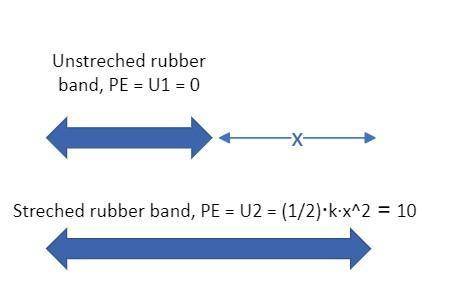
Physics, 21.10.2020 04:01 kingalex7575
1) If you release a rubber band that had 10 units of elastic energy, 12 units of movement energy cannot be produced. Why not?
2) For the rubber band in question 3, what would its percentage efficiency be if 7 units of movement energy were produced? Where have the remaining 3 units of energy gone?
3) What are the by-product energy transformations for a car?

Answers: 1


Another question on Physics

Physics, 22.06.2019 00:30
Next a skier is pulled by a tow rope up a frictionless ski slope that makes an angle of 15 with the horizontal. the rope moves parallel to the slope with a constant speed of 0.69 m/s. the force of the rope does 800 3 of work on the skier as the skier moves a distance of 8.4 m up the incline. (a) if the rope moved with a constant speed of 2.2 m/s how much work would the force of the rope do on the skier as the skler moved a distance of 8.4 m up the incline? at what rate is the force of the rope doing work on the skier when the rope moves with a speed of (b) 0.69 m/s and (c) 2.2 m/s?
Answers: 1

Physics, 22.06.2019 02:30
Explain the difference between each pair of concepts. a. frequency and relative frequency b. percentage and relative frequency a. select the correct choice below. a. frequency is the total number of observations in a data set. relative frequency is the number of times a particular distinct value occurs. b. frequency is the number of times a particular distinct value occurs. relative frequency is the ratio of the frequency of a value to the total number of observations. c. frequency is the total number of observations in a data set. relative frequency is the ratio of the number of times a particular distinct value occurs to the frequency. d. frequency is the number of times a particular distinct value occurs. relative frequency is the ratio of the frequency of two different values.
Answers: 3

Physics, 22.06.2019 11:50
An electron is traveling with initial kinetic energy k in a uniform electric field. the electron comes to rest momentarily after traveling a distance d. (a) what is the magnitude of the electric field
Answers: 3

Physics, 22.06.2019 12:30
Apositive charge moves in the direction of an electric field. which of the following statements are true? check all that apply. check all that apply. 1.the potential energy associated with the charge decreases. 2. the electric field does positive work on the charge. 3. the electric field does negative work on the charge. 4. the potential energy associated with the charge increases. 5. the electric field does not do any work on the charge. 6. the amount of work done on the charge cannot be determined without additional information.
Answers: 1
You know the right answer?
1) If you release a rubber band that had 10 units of elastic energy, 12 units of movement energy can...
Questions

Biology, 02.07.2019 12:00



Mathematics, 02.07.2019 12:00

Mathematics, 02.07.2019 12:00

History, 02.07.2019 12:00

History, 02.07.2019 12:00


Social Studies, 02.07.2019 12:00


History, 02.07.2019 12:00

Mathematics, 02.07.2019 12:00

History, 02.07.2019 12:00

History, 02.07.2019 12:00

Mathematics, 02.07.2019 12:00





Mathematics, 02.07.2019 12:00




